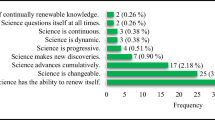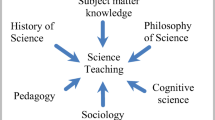Abstract
The aim of developing students’ understanding of the nature of science [NOS] has been considered an important aspect of science education. However, the results of previous research indicate that students of various ages and even teachers possess both inaccurate and inappropriate views of the NOS. Such a failure has been explained by the view that perceptions about the NOS are well assimilated into mental structures and resistant to change. Further, the popularization of pseudoscience by the media and the assimilation of pseudoscience into previously established scientific fields have been presented as possible reasons for erroneous popular perceptions of science. Any teaching intervention designed to teach the NOS should first provoke individuals to expose their current ideas in order to provide them the chance to revise or replace these conceptual frameworks. Based on these assumptions, the aim of this study was to determine whether a teaching context based on the issue of demarcation would provide a suitable opportunity for exposing and further developing the NOS understandings of individuals enrolled in a teacher education course. Results indicate that a learning intervention based on the issue of demarcation of science from pseudoscience (in the specific case of astrology) proved an effective instructional strategy, which a majority of teacher candidates claimed to plan to use in their future teachings.
Similar content being viewed by others
References
Abd-El-Khalick, F., Bell, R. L., & Lederman, N. G. (1998). The nature of science and instructional practice: Making the unnatural natural. Science Education, 82, 417–436.
Abd-El-Khalick, F., & Lederman, N. G. (2000a). Improving science teachers’ conceptions of nature of science: A critical review of literature. International Journal of Science Education, 22, 665–701.
Abd-El-Khalick, F., & Lederman, N. G. (2000b). The influence of history of science courses on students’ views of nature of science. Journal of Research in Science Teaching, 37(10), 1057–1095.
Aikenhead, G. S. (1997). Toward a first nations cross-cultural science and technology curriculum. Science Education, 81, 217–238.
Alters, B. J. (1997). Whose nature of science? Journal of Research in Science Teaching, 34, 39–55.
American Association for the Advancement of Science [AAAS]. (1989). Science for all Americans. Washington DC: American Association for the Advancement of Science.
Argyris, C., & Schon, D. (1974). Theory in practice. San Francisco: Josey-Bass.
Bartholomew, H., Osborne, J., & Ratcliffe, M. (2004). Teaching students ‘ideas about science’: Five dimensions of effective practice. Science Education, 88(5), 655–682.
Bauer, H. H. (2002). Pathological science is not scientific misconduct nor is it pathological. International Journal for Philosophy of Chemistry, 8(1), 5–20.
Berg, B. (2007). Qualitative research methods for the social sciences (6th ed.). Boston: Pearson.
Bogden, R. C., & Biklen, S. K. (2007). Qualitative research for education: An introduction to theories and methods. Boston: Allyn and Bacon.
Bravo, A. A. (2004). Methodology and politics: A proposal to teach the structuring ideas of the philosophy of science through the pendulum. Science & Education, 13, 717–731.
Bravo, A. A., Merce, I., & Anna, E. (2001). A characterisation of practical proposals to teach the philosophy of science to prospective science teachers. Paper Presented at the IOSTE Symposium, Paralimni, Cyprus.
Bunge, M. (1989). The popular perception of science. Transactions of the Royal Society of Canada, 5(4), 269–280.
Castelao, T. (2002). Epistemology of science, science literacy, and the demarcation criterion: The nature of science (NOS) and informing science (IS) in context. Paper Presented at the Informing Science & IT Education Joint Conference: InSITE ‘Where Parallels Intersect’, Cork, Ireland.
Creswell, J. W. (2005). Educational research: Planning, conducting and evaluating quantitative and qualitative research. Upper Saddle River, NJ: Pearson Education, Inc.
Dilworth, C. (2006). The metaphysics of science: An account of modern science in terms of principles, laws and theories (2nd ed.). Dordrecht, The Netherlands: Springer.
Driver, R., Leach, J., Millar, R., & Scott, P. (1996). Young people’s images of science. Buckingham: Open University Press.
Duschl, R. (1990). Restructuring science education: The importance of theories and their development. New York: Teachers College Press.
El-Hani, C. N., & Mortimer, E. F. (2007). Multicultural education, pragmatism, and the goals of science teaching. Cultural Studies of Science Education, 2, 657–702.
Gauch, H. G. (2009). Science, worldviews and education. Science & Education, 18, 667–695.
Gay, L. R., Mills, G. E., & Airasian, R. (2006). Educational research: Competencies for analysis and applications (8th ed.). Upper Saddle River, NJ: Pearson/Merrill/Prentice Hall.
Gillies, D. (1998). Philosophy of science in the 20th century: Four central themes. Oxford, UK: Blackwell Publishers.
Glesne, C. (2006). Becoming qualitative researchers: An introduction. New York: Pearson.
Hammrich, P. L. (1997). Confronting teacher candidates’ conceptions of the nature of science. Journal of Science Teacher Education, 8(2), 141–151.
Irez, S., & Cakir, M. (2006). Critical reflective approach to teach the nature of science. Journal of Turkish Science Education, 6, 19–35.
Kang, S., Scharmann, L. C., & Noh, T. (2005). Examining students’ views on the nature of science: Results from Korean 6th, 8th, and 10th graders. Science Education, 89(2), 314–334.
Kitcher, P. (1982). Abusing science: The case against creationism. MIT-Press: Cambridge, MA.
Kuhn, T. (1970). Logic of discovery or psychology of research? In I. Lakatos & A. Musgrave (Eds.), Criticism and the growth of knowledge (pp. 1–23). Cambridge: Cambridge University Press.
Ladyman, J. (2007). Ontological, epistemological and methodological positions. In T. A. Kuipers (Ed.), General philosophy of science: Focal issues (pp. 303–376). Nort Holland: Elsevier.
Lakatos, I. (1970). Falsification and the methodology of scientific research programmes. In I. Lakatos & A. Musgrave (Eds.), Criticism and the growth of knowledge (pp. 91–195). Cambridge: Cambridge University Press.
Lakatos, I. (1981). Science and pseudoscience. In S. Brown, et al. (Eds.), Conceptions of inquiry: A reader (pp. 114–121). Methuen: London.
Laplante, B. (1997). Teachers’ beliefs and instructional strategies in science; Pushing analysis further. Science Education, 81(3), 277–294.
Laudan, L. (1983). The demise of the demarcation problem. In R. S. Cohen & L. Laudan (Eds.), Physics, philosophy and psychoanalysis (pp. 111–127). Dordrecht: Reidel.
Lederman, N. G. (1992). Students’ and teachers’ conceptions of the nature of science: A review of the research. Journal of Research in Science Teaching, 29(4), 331–359.
Lederman, N. G., Abd-El-Khalick, F., Bell, R. L., & Schwartz, R. (2002). Views of nature of science questionnaire: Toward valid and meaningful assessment of learners’ conceptions of nature of science. Journal of Research in Science Teaching, 39(6), 497–521.
Lilienfeld, S. O. (2004). Teaching psychology students to distinguish science from pseudoscience: Pitfalls and rewards. In B. K. Saville (Ed.), Essays from excellence in teaching (pp. 26–32). Society for the Teaching of Psychology.
Lilienfeld, S. O., Lohr, J. M., & Morier, D. (2001). The teaching of courses in science and pseudoscience of psychology: Useful resources. Teaching of Psychology, 28, 182–191.
Mahner, M. (2007). Demarcating science from nonscience. In T. A. Kuipers (Ed.), General philosophy of science: Focal issues (pp. 515–576). Nort Holland: Elsevier.
Mats, L. (2007). Students’ beliefs in pseudoscience. Paper Presented at ESERA, Malmö, Sweden.
Matthews, M. (1998). In defense of modest goals when teaching about the nature of science. Journal of Research in Science Teaching, 35(2), 161–174.
Matthews, M. (2000). Time for science education: How teaching the history and philosophy of pendulum motion can contribute to science literacy. NY: Plenum Publishers.
Maxwell, J. A. (2005). Qualitative research design: An interactive approach (2nd ed.). Thousand Oaks, CA: Sage Publications.
McComas, W. F., Clough, M. P., & Almazroa, H. (2000). The role and character of the nature of science in science education. In W. F. McComas (Ed.), The nature of science in science education: Rationales and strategies (pp. 3–39). Dordrecht: Kluwer.
Meichtry, Y. J. (1992). Influencing student understanding of the nature of science: Data from a case of curriculum development. Journal of Research in Science Teaching, 29(4), 389–407.
Meichtry, Y. J. (1993). The impact of science curricula on students views about the nature of science. Journal of Research in Science Teaching, 30, 429–443.
Merriam, S. (1998). Qualitative research and case studies application in education. San Francisco: Jossey-Bass.
Miles, M. B., & Huberman, A. M. (1994). Qualitative data and analysis: An expanded sourcebook (2nd ed.). Thousand Oaks, CA: Sage Publications.
Morier, D., & Keeports, D. (1994). Normal science and the paranormal: The effect of a scientific method course on students’ beliefs in the paranormal. Research in Higher Education, 35, 443–453.
National Research Council [NRC]. (1996). National science education standards. Washington DC: National Academy Press.
Nickles, T. (2006). Problem of demarcation. In S. Sarkar & J. Pfeifer (Eds.), The philosophy of science an Encyclopedia (pp. 188–197). New York: Routledge.
Nott, M., & Wellington, J. (1996). Probing teachers’ views of the nature of science: How should we do it and where should we be looking? In G. Welford, J. Osborne, & P. Scott (Eds.), Research in science education in Europe: Current issues and themes (pp. 283–294). London: Falmer Press.
Popper, K. (1963). Conjectures and refutations. New York: Basic Books.
Preece, P. F., & Baxter, J. H. (2000). Scepticism and gullibility: The superstitious and pseudoscientific beliefs of secondary school students. International Journal of Science Education, 22(11), 1147–1156.
Rouse, J. (2003). Kuhn’s philosophy of scientific practice. In T. Nickles (Ed.), Thomas Kuhn (pp. 101–121). Cambridge: Cambridge University Press.
Ryder, J., Leach, J., & Driver, R. (1999). Undergraduate science students’ images of science. Journal of Research in Science Teaching, 36(2), 201–219.
Scharmann, L. C., Smith, M. U., James, M. C., & Jensen, M. (2005). Explicit reflective nature of science instruction: Evolution, intelligent design & umbrellology. Journal of Science Teacher Education, 16, 27–41.
Smith, M. U., Lederman, N. G., Bell, R. L., McComas, W. F., & Clough, M. P. (1997). How great is the disagreement about the nature of science? A response to Alters. Journal of Research in Science Teaching, 34, 1101–1104.
Smith, M. U., & Scharmann, L. C. (1999). Defining versus describing the nature of science: A pragmatic analysis for classroom teachers and science educators. Science Education, 83(4), 493–509.
Strauss, A., & Corbin, J. (1998). Basics of qualitative research: Grounded theory procedures and techniques. Newbury Park, CA: Sage Publications, Inc.
Suchting, W. (1995). The nature of scientific thought. Science & Education, 4(1), 1–22.
Thagard, P. (1988). Computational philosophy of science. Cambridge, MA: MIT Press.
Tobin, K., & McRobbie, C. J. (1997). Beliefs about the nature of science and the enacted curriculum. Science & Education, 6(4), 335–371.
Wesp, R., & Montgomery, K. (1998). Developing critical thinking through the study of paranormal phenomena. Teaching of Psychology, 25, 275–278.
Zeidler, D. L., Walker, K. A., Ackett, W. A., & Simmons, M. L. (2002). Tangled up in views: Beliefs in the nature of science and responses to socioscientific dilemmas. Science Education, 86, 343–367.
Acknowledgments
The author would like to appreciate helpful comments on earlier versions of this paper from Michael Matthews, Serhat Irez, and anonymous reviewers.
Author information
Authors and Affiliations
Corresponding author
Rights and permissions
About this article
Cite this article
Turgut, H. The Context of Demarcation in Nature of Science Teaching: The Case of Astrology. Sci & Educ 20, 491–515 (2011). https://doi.org/10.1007/s11191-010-9250-2
Published:
Issue Date:
DOI: https://doi.org/10.1007/s11191-010-9250-2




